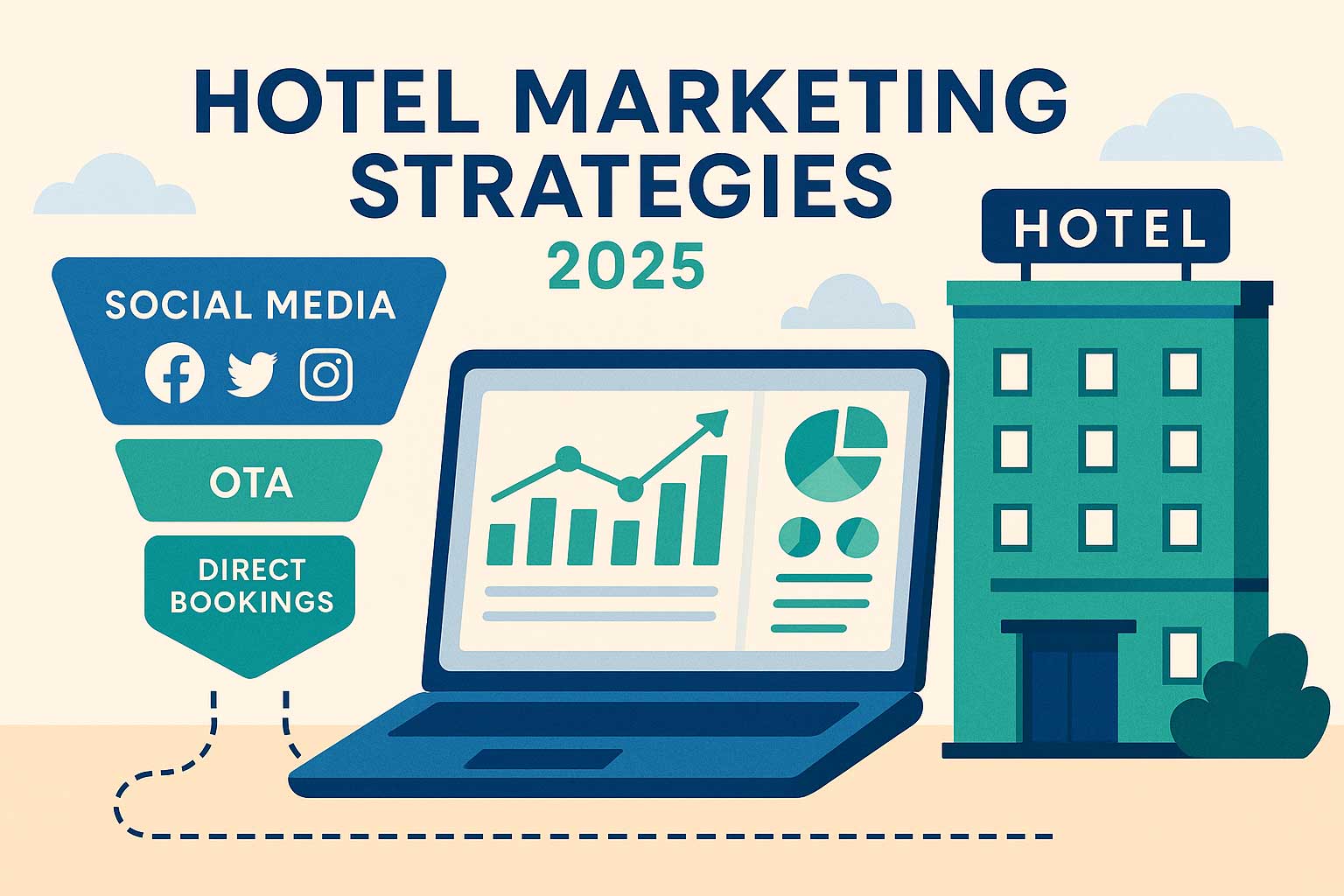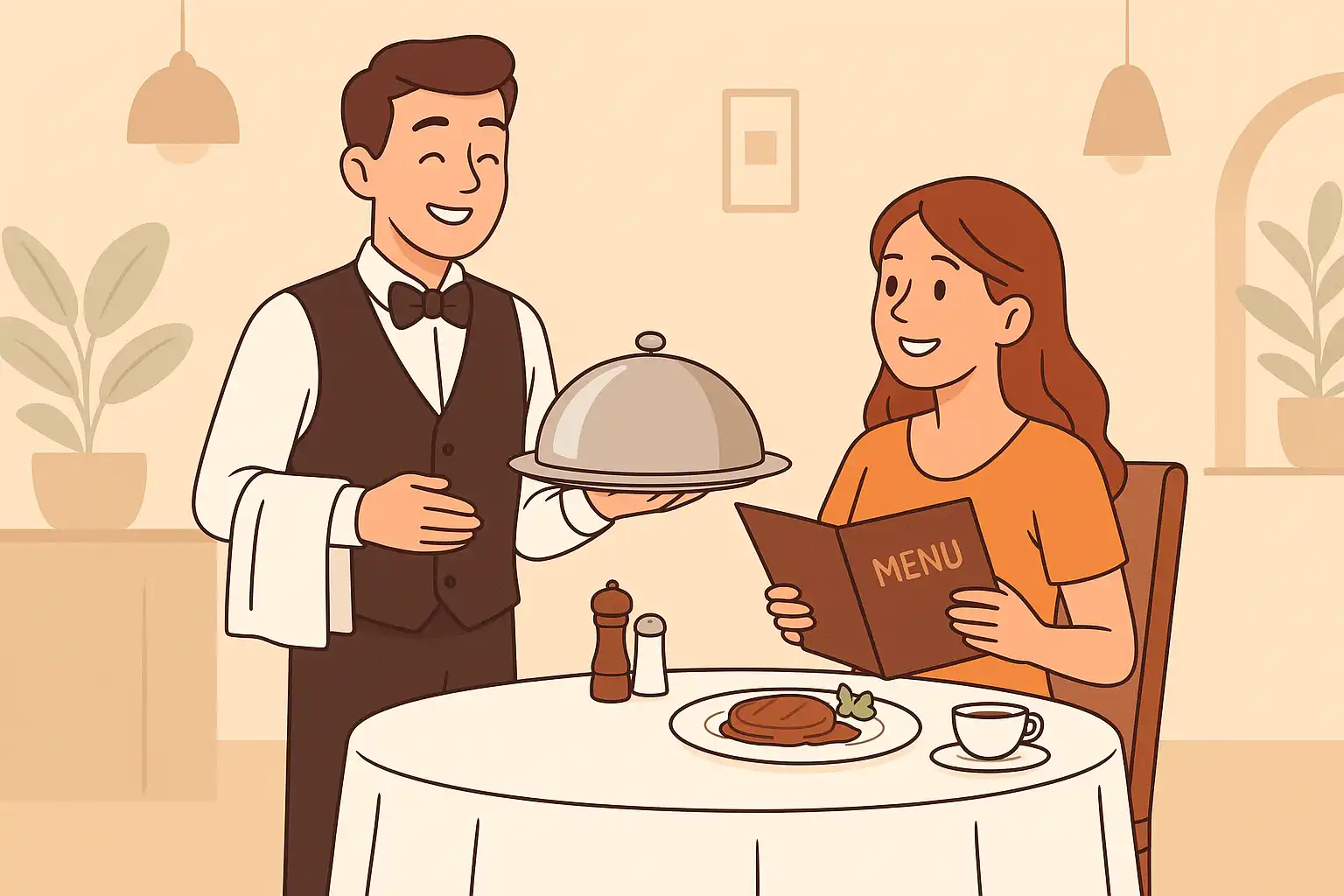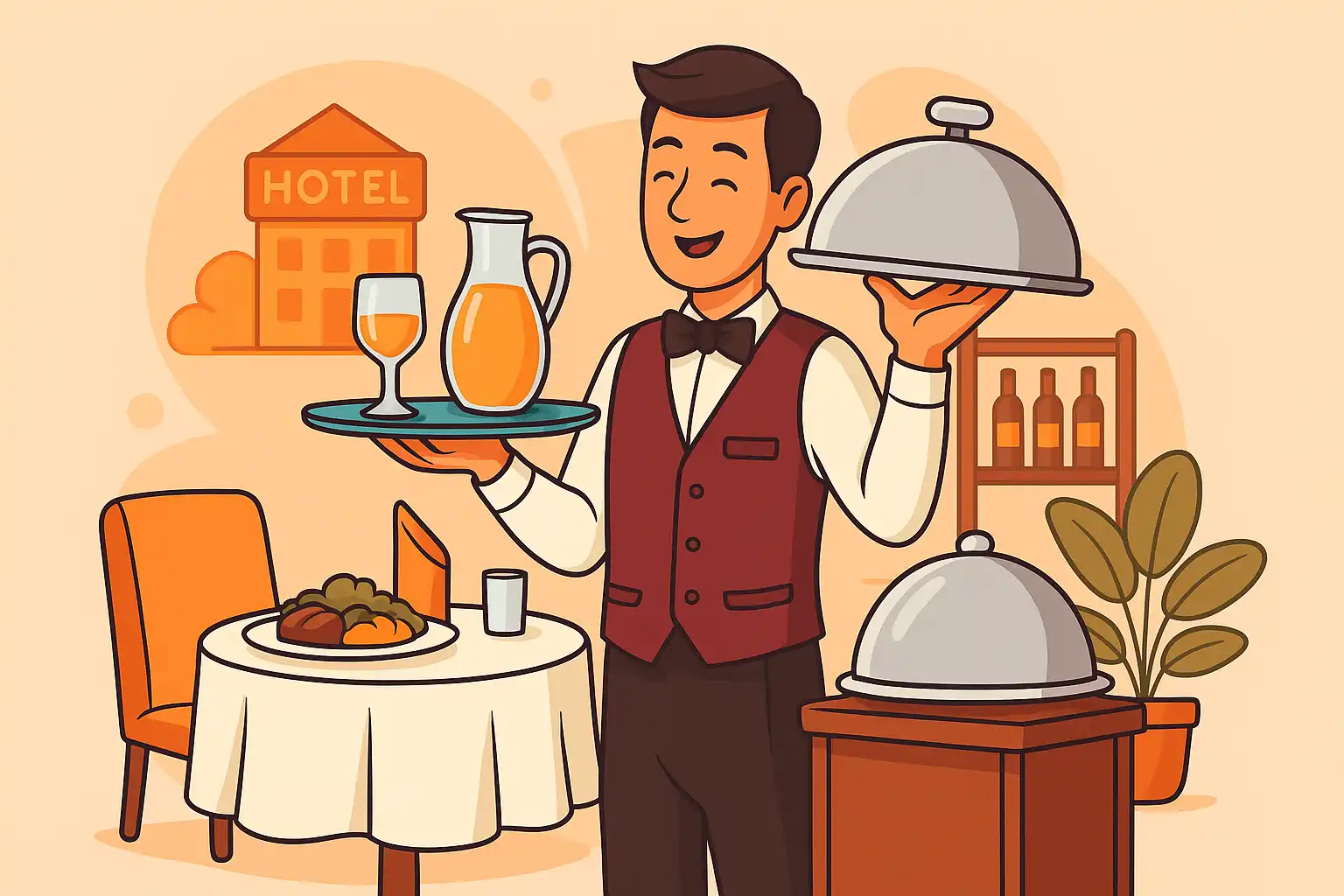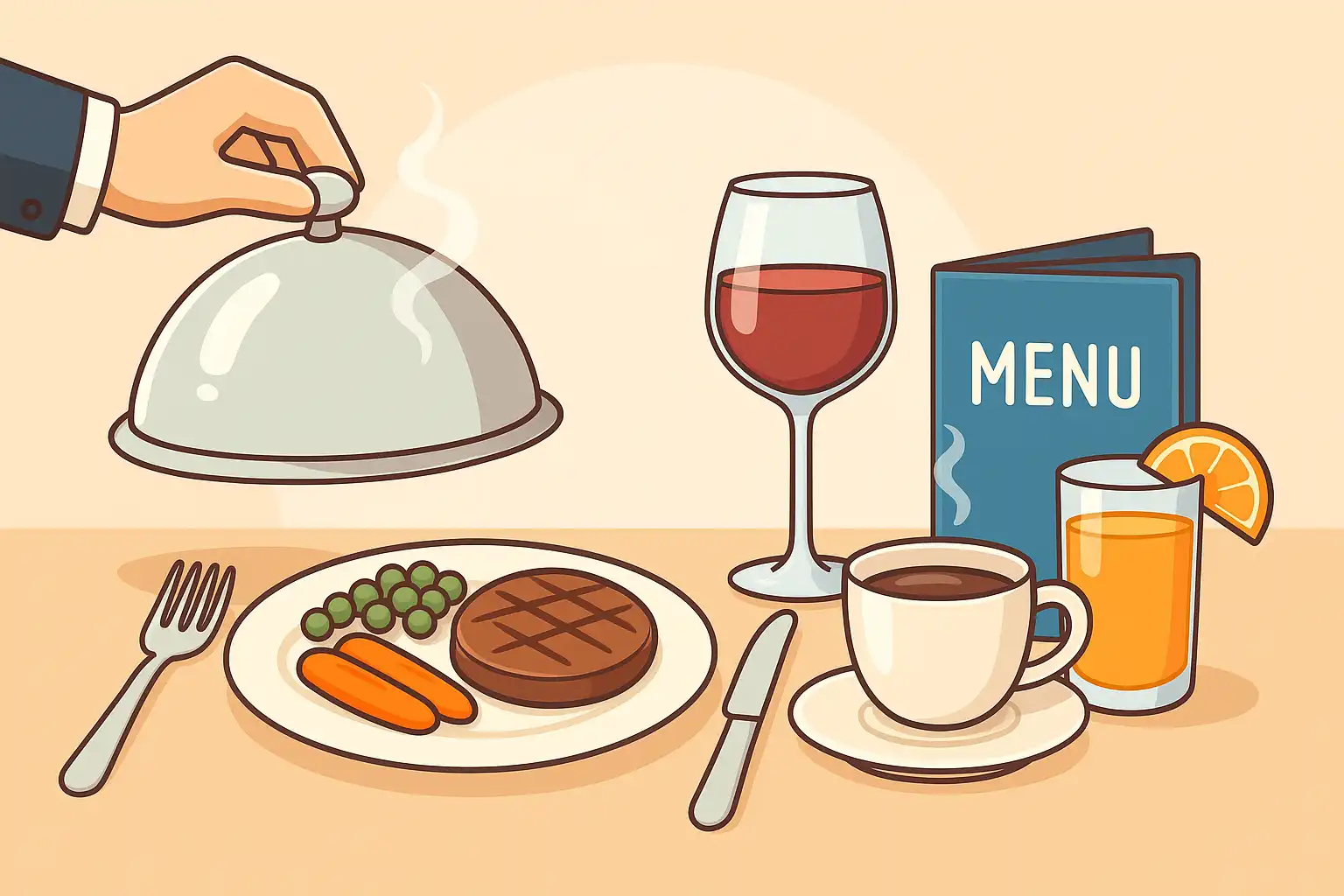Guide to Food and Beverage Service in Hotel Operations
Oct 19, 2025
 Mika Takahashi
Mika TakahashiPopular Categories
Hotel Technology & InnovationHotel Operations OptimizationDigital MarketingIndustry TrendsRevenue ManagementHospitality Industry
Popular Categories
Trending Post

Hotel Walk Letter Template: Professional Guest Communication

Online Travel Agents: What They Are and How They Work

Hotel Security Systems: Modern Protection Solutions

Hotel Advertising: Complete Guide to Boost Bookings and Revenue

25 Hotel Marketing Strategy Ideas for 2025: Complete Guide

AI Reservation Agent: Revolutionizing Hotel Booking and Guest Experience

PMS Communication: Streamlining Property Management Through Effective Guest Messaging
Table of contents
Food and beverage service in hotels is so much more than just serving meals to guests. In today’s fast-paced and competitive hospitality industry, F&B services have grown into vital revenue centers that play a big role in guest satisfaction, brand reputation, and overall profitability. Hotels now blend diverse dining concepts, innovative technology, and top-notch service standards to create memorable experiences that go far beyond just a place to sleep.
Whether it’s an intimate fine dining restaurant led by a celebrity chef, convenient 24/7 room service, or grand banquet halls hosting special events, hotel food and beverage services cover a wide range of culinary offerings. These operations often bring in 20-30% of a hotel’s total revenue, making them key profit generators that demand smart management and smooth operations.
In this guide, we’ll dive into everything you need to know about hotel food and beverage services — from how they operate and impact revenue to the latest trends and exciting career paths in this ever-evolving sector.

What is Food and Beverage Service in Hotels?
Food and beverage service in hotels includes all the dining and drinking venues within a hotel — from fine dining restaurants and bustling lobby bars to convenient room service and cozy coffee shops. This isn’t just about offering food; it’s about crafting immersive culinary experiences that enhance guest satisfaction and bring in significant revenue.
Normally, hotel F&B services generate 20-30% of total hotel revenue, and in luxury hotels, this share can be even higher — especially when multiple in house restaurants, banquet spaces, and local clientele come into play. For example, iconic hotels like The Ritz-Carlton often see per-outlet revenues topping $1 million annually in prime markets.
The variety of service offerings is wide: continental breakfasts, casual coffee shops, Michelin-starred dining, rooftop cocktail lounges, and more. Many full-service hotels operate several outlets — like a casual all-day restaurant, a specialty bar, room service, and banquet facilities — to cover diverse guest preferences throughout the day.
Today’s hotel food and beverage operations in hotels also embrace technology, sustainability, and personalization. Guests expect mobile ordering, menus that cater to dietary needs, locally sourced ingredients, and visually stunning dishes that are perfect for sharing on social media.
What was once simple meal provision has transformed into a sophisticated culinary destination that attracts not only hotel guests but also locals. This shift has elevated the food and beverage sector into a core part of hotel branding and a key differentiator in a crowded market.
Types of Food and Beverage Services in Hotels
Hotel food and beverage services in hotels come in many forms, each designed to meet different guest needs and maximize revenue. By offering a strategic mix of dining options, hotels can appeal to a broad range of guests and optimize operational efficiency.
Every type of service has its own unique operational demands, staffing needs, and technology requirements. From intimate fine dining spots with sommeliers to high-volume banquet halls requiring precise coordination, successful food and beverage management means understanding these differences and delivering excellence across the board.
Many hotels run 3-5 different F&B outlets to capture various guest segments and meal times. This approach serves business travelers looking for a quick breakfast, families wanting casual meals, couples seeking romantic dinners, and corporate groups needing flexible event catering.
Restaurant and Fine Dining Services
Hotel restaurants span from casual all-day dining to award-winning fine dining experiences led by celebrity chefs. These venues are often the heart of the guest experience and major revenue drivers, shaping the hotel’s culinary reputation and attracting both travelers and locals.
Fine dining spots in luxury hotels often offer tasting menus priced between $150 and $300 per person, complete with wine pairings. These restaurants highlight innovative cuisine, premium ingredients, extensive wine lists, and personalized service that rivals standalone Michelin-starred establishments. Executive chefs here usually have prestigious culinary backgrounds and work closely with local suppliers to ensure top-notch food quality in hotels.
Casual dining outlets provide international dishes, local favorites, and family-friendly menus with average checks of $40-80. These venues focus on comfort, accessibility, and consistent quality, blending global and regional flavors to satisfy diverse guest preferences and dietary needs.
Many hotels collaborate with renowned restaurant brands like Nobu, Wolfgang Puck, or Gordon Ramsay. These partnerships leverage celebrity chef fame and established culinary brands to boost food and beverage revenue while enhancing the hotel’s prestige and market appeal.

Room Service Operations
Room service offers guests the convenience of dining in their rooms, often available 24/7 in luxury hotels and during limited hours in mid-scale properties. This service has grown in popularity, especially after the pandemic, as guests seek private dining and contactless delivery options.
Typical hotel room service orders range from $25 to $60 per person, with delivery times averaging 30-45 minutes. Successful room service operations rely on efficient logistics to maintain food quality, proper temperature, and timely delivery across potentially hundreds of rooms. High-end hotels often guarantee fast delivery and offer extensive menus comparable to their restaurants.
Modern room service is increasingly tech-driven, featuring mobile app ordering, contactless delivery, and specialized breakfast packages. Some properties even employ autonomous delivery robots or QR code-based ordering systems to enhance guest convenience.
Luxury hotels may elevate room service further with butler service for suites, offering personalized meal preparation, fine china, linens, and attentive staff to create a restaurant-quality dining experience right in the guest’s room.
Banquet and Event Catering
Hotel banquet and catering services play a crucial role in hosting weddings, corporate events, and social gatherings, accommodating anywhere from 20 to 2,000 guests. These operations bring in significant revenue but require complex logistics, specialized equipment, and adaptable spaces to meet diverse event needs.
Wedding packages typically range from $80 to $250 per person, depending on menu and service levels. Catering for weddings has become a major revenue stream, with couples seeking all-inclusive packages covering venues, receptions, accommodations, and beverage management. Many hotels employ dedicated wedding coordinators and preferred vendor relationships to simplify planning.
Corporate catering includes breakfast meetings, lunch conferences, and evening receptions, often requiring flexibility for last-minute changes and dietary restrictions. Hotels frequently offer standardized corporate packages to streamline bookings and ensure smooth operations.
Event venues are equipped with flexible room setups, audiovisual gear, and dedicated event staff. Modern banquet halls can transform from intimate boardrooms to grand ballrooms quickly, thanks to modular furniture and advanced lighting and projection systems.
Bar and Lounge Services
Hotel bars range from lobby lounges and rooftop venues to sports bars and craft cocktail spots. These spaces serve multiple purposes: gathering places for guests, revenue generators, and brand enhancers that attract both hotel visitors and local patrons.
Cocktails typically cost $15-25, and wine by the glass ranges from $12-30. Successful hotel bars focus on creating unique atmospheres, curating specialty drink menus, and training skilled bartenders who can craft classic and signature cocktails alike. Beverage operations often yield higher profit margins than food, making bars especially valuable revenue centers.
Specialty bars like whiskey lounges, wine cellars, and champagne bars add unique flair, helping hotels stand out and appeal to niche guest interests. Rooftop bars and craft cocktail lounges have become Instagram-worthy spots that generate buzz and attract younger crowds.
Happy hour specials, wine tastings, mixology classes, and live entertainment turn hotel bars into vibrant community hubs, boosting beverage sales and strengthening local market presence.
Food and Beverage Department Structure and Roles
The food and beverage department is often the largest in a hotel, employing 40-60% of total staff. This reflects how labor-intensive food and beverage operations are, requiring skilled professionals across multiple outlets, kitchens, and administrative roles.
The department hierarchy usually includes the F&B Director, restaurant managers, supervisors, and frontline associates. The F&B Director oversees all dining venues, manages budgets, develops marketing strategies, and ensures consistent service standards. Restaurant managers focus on their specific outlets, staff development, and guest satisfaction.
Staffing ratios vary by service type — fine dining may require one server per 3-4 tables, while banquet events might use one server per 8-10 guests. These ratios impact service quality, operational costs, and revenue potential. Luxury hotels maintain higher staffing levels to provide personalized service, while casual venues optimize efficiency.
Cross-training staff across outlets helps reduce labor costs and offers career growth opportunities. Successful F&B departments invest in training programs that prepare employees to work in multiple venues, easing scheduling and boosting skills.

Front of House Operations
Front of house roles include servers, bartenders, hosts, sommeliers, and guest relations coordinators — all the faces guests see and interact with. These positions greatly influence customer satisfaction, repeat visits, and online reviews that shape the hotel’s reputation.
Restaurant servers in upscale hotels typically earn $15-25 per hour plus tips, while sommeliers can make $50,000-80,000 annually. Compensation often includes base pay, tip sharing, and performance bonuses tied to guest satisfaction and outlet revenue.
Training programs usually last 2-4 weeks and cover wine knowledge, food allergies, POS systems, and service standards. Ongoing education ensures staff can handle complex requests, accommodate dietary restrictions, and recommend food and beverage pairings knowledgeably. Many hotels require certifications for beverage service roles.
Frontline staff must maintain professional appearance and cultural sensitivity, as hotel guests come from diverse backgrounds with different dining customs and service expectations.
Back of House Operations
Back of house includes executive chefs, sous chefs, line cooks, prep staff, dishwashers, and storeroom personnel. These behind-the-scenes teams ensure food quality, kitchen efficiency, and compliance with health regulations, maintaining the culinary standards that define the hotel’s dining reputation.
Executive chefs in luxury hotels earn $80,000-150,000 annually and often have formal culinary education or apprenticeships. They develop menus, manage kitchen operations, control food costs, mentor staff, and maintain supplier relationships to ensure consistent quality.
Kitchen staff must have HACCP certification, food safety training, and follow local health department rules. Food safety is critical, requiring ongoing training, documentation, and monitoring to prevent illness and keep permits valid.
Inventory management systems track food costs, waste, and supplier performance. Modern hotels use advanced software to monitor ingredient use, predict demand, optimize purchasing, and maintain quality while controlling costs.
Revenue Impact and Financial Performance
In the U.S., hotel food and beverage operations contribute between $2.5 and $4.5 billion annually to the hospitality industry’s revenue. This underscores how important F&B services are to hotel profitability and employment.
Successful F&B departments achieve profit margins of 25-35%, while poorly managed ones may lose 5-15%. Profitability hinges on cost control, menu design, staff productivity, and revenue optimization across multiple outlets. Hotels must balance guest satisfaction with financial goals through smart pricing and efficient operations.
Food costs typically represent 28-35% of F&B revenue, with beverage costs at 18-25%. These benchmarks guide purchasing, menu pricing, and portion control. Beverage operations usually offer higher margins than food, making bars and wine programs especially valuable revenue streams.
Hotels with quality F&B amenities see RevPAR (Revenue Per Available Room) increases of 15-25%. This shows how exceptional dining boosts property value and guest willingness to pay premium rates, while driving positive reviews and repeat bookings.
| Service Type | Typical Profit Margin | Average Revenue per Guest | Operational Complexity |
|---|---|---|---|
| Fine Dining | 15-25% | $80-200 | High |
| Casual Dining | 20-30% | $40-80 | Medium |
| Room Service | 25-35% | $35-60 | Medium-High |
| Banquet Services | 30-40% | $80-250 | Very High |
| Bar Operations | 60-75% | $25-50 | Medium |
Guest Experience and Customer Satisfaction
The quality of food and beverage service directly impacts hotel ratings on sites like TripAdvisor — poor restaurant reviews can lower overall hotel scores by 0.5 to 1.0 points. This highlights how crucial consistent food quality, exceptional service, and meeting guest preferences are to online reputation and future bookings.
Surveys show 73% of travelers consider on-site dining options when choosing hotels. This underscores how much F&B amenities influence booking decisions, especially for leisure travelers and extended-stay guests who value convenient, high quality food.
Dietary accommodation requests have risen 45% since 2020, including vegan, gluten-free, and allergen-sensitive needs. Hotels must adapt menus and kitchen processes to meet these evolving expectations while maintaining food safety and operational efficiency.
Instagram-worthy food presentation generates 35% more social media engagement for hotel brands. Visual appeal is more important than ever as guests share their dining experiences online, creating organic marketing that attracts new customers and boosts brand visibility.
The guest experience covers many touchpoints — from booking and seating to food quality and service delivery. Successful hotels develop comprehensive service standards to ensure consistency across all F&B outlets while personalizing experiences based on guest preferences and dietary needs.
Technology Integration in Hotel F&B
Mobile ordering apps boost average order values by 18-25% and cut labor costs by 15-20%. Technology has transformed hotel food and beverage operations by streamlining ordering, improving efficiency, enhancing guest convenience, and generating valuable data insights.
QR code menus became standard in 85% of hotel restaurants following the COVID-19 pandemic. This shift eliminated physical menus while enabling dynamic pricing, real-time updates, and contactless ordering—features that appeal to health-conscious guests and improve operational flexibility.
AI-powered inventory systems reduce food waste by 20-30% and optimize purchasing decisions. Advanced analytics help hotels predict demand, minimize spoilage, maintain optimal stock levels, control costs, and support sustainability efforts.
Contactless payment options like Apple Pay and Google Wallet now account for 60% of F&B transactions. These payment technologies speed up processing, reduce cash handling, and enhance security while meeting guest preferences for seamless, touchless payments.
Modern hotel F&B technology includes integrated point-of-sale systems, kitchen display screens, customer relationship management platforms, and delivery tracking apps that streamline operations and provide detailed analytics for revenue growth and operational improvements.
Current Trends Shaping Hotel F&B Services
Plant-based menu options in hotel restaurants jumped 67% between 2021 and 2024, reflecting growing guest demand for sustainable, health-conscious choices. This trend drives menu innovation and staff training to ensure quality preparation and presentation.
Local sourcing initiatives support community partnerships and cut food transportation costs by 15-25%. Hotels increasingly highlight regional ingredients, farm-to-table concepts, and local supplier relationships to appeal to environmentally responsible guests while supporting local economies.
Ghost kitchens and delivery-only concepts add new revenue streams worth $50,000-200,000 annually per hotel. These virtual restaurants use existing kitchen space to serve off-premises customers through delivery platforms, maximizing facility use and reaching new markets.
Sustainability certifications like Green Restaurant Association membership attract eco-conscious travelers. Hotels pursue these credentials to show commitment to sustainable practices and appeal to guests who prioritize environmentally friendly hospitality options.
The hospitality sector continues to evolve through technology, shifting consumer demands, and sustainability awareness — all driving innovation in menu design, service delivery, and operations across the food and beverage industry.

Career Opportunities in Hotel Food and Beverage
Careers in hotel food and beverage offer growth from entry-level server roles ($25,000-35,000) to senior positions like F&B Director ($85,000-150,000). This progression highlights the great potential for motivated professionals who develop essential skills and leadership qualities.
Culinary graduates can advance from line cook ($28,000-38,000) to executive chef ($65,000-120,000) within 8-12 years. Success in culinary careers requires dedication, continuous learning, and hands-on experience across various kitchen stations, along with strong mentorship and networking.
Beverage specialists such as sommeliers and mixologists earn premium salaries of $45,000-85,000 in luxury hotels. Expertise in beverage management, certification, and exceptional customer service open valuable career paths in high-end properties that prioritize outstanding beverage programs.
Major hotel companies like Marriott, Hilton, and Hyatt offer structured management training and international transfer opportunities. These global hospitality brands provide clear career development pathways, including cross-functional training, leadership growth, and global mobility for ambitious professionals.
The hospitality business offers diverse career options in restaurant management, beverage management, event coordination, and operational roles — all requiring strong organizational skills, cultural awareness, and a deep understanding of guest expectations in this dynamic, ever evolving industry.
| Position Level | Entry Salary Range | Experience Required | Key Skills |
|---|---|---|---|
| Server/Bartender | $25,000-35,000 | 0-2 years | Customer service, multitasking |
| Supervisor | $35,000-45,000 | 2-4 years | Leadership, training |
| Assistant Manager | $45,000-65,000 | 4-6 years | Operations, staff management |
| Restaurant Manager | $55,000-85,000 | 6-8 years | P&L responsibility, guest relations |
| F&B Director | $85,000-150,000 | 10+ years | Strategic planning, multi-outlet management |
Building a successful career in hotel food and beverage requires a blend of exceptional service standards, cost control expertise, tech savvy, and the ability to meet guest expectations while managing complex operations. Professionals who master these skills and maintain strong guest satisfaction metrics can enjoy rewarding advancement opportunities in hospitality management.
Food and beverage service in hotel operations is a vibrant, multifaceted industry that combines culinary creativity, operational excellence, and business insight. From intimate fine dining to large-scale banquets, hotel F&B services create memorable dining experiences while driving significant revenue and guest loyalty.
Whether you’re a hospitality professional aiming to grow or someone considering a career in hotel management, the food and beverage sector offers diverse opportunities for growth, creativity, and leadership in an industry that continually adapts to emerging trends, technology, and evolving consumer preferences.
